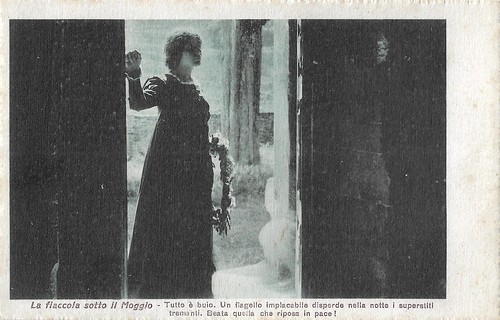
Italian postcard. Photo: Ambrosio. Anna De Marco as Gigliola in La fiaccola sotto il moggio/The Torch under the Bushel (Eleuterio Rodolfi, 1916). Caption: "All was dark. An unrelenting scourge scatters in the night the trembling survivors. Blessed is the one who rests in peace!" The vengeful Gigliola visits the grave of her mother in the family chapel, one year after the murder. She holds a wreath in her hands.
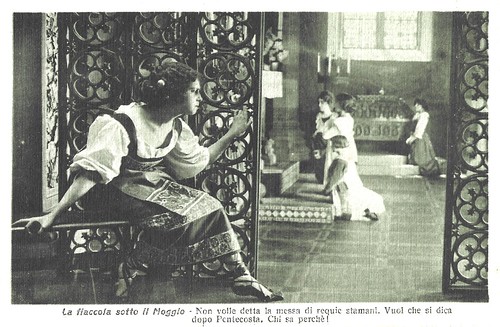
Italian postcard by Duplex IPA CT. V. Uff. Rev. St. Terni, card 1 of 10, no. 3885. Photo: Film. Soc. An. Ambrosio, Torino. Helena Makowska as Angizia in La fiaccola sotto il moggio/The Torch under the Bushel (Eleuterio Rodolfi, 1916). Caption: She didn't want the requiem mass to be celebrated today. She wants to do it after Pentecost. Who knows why? [Angizia watches the Di Sangro family attending mass].
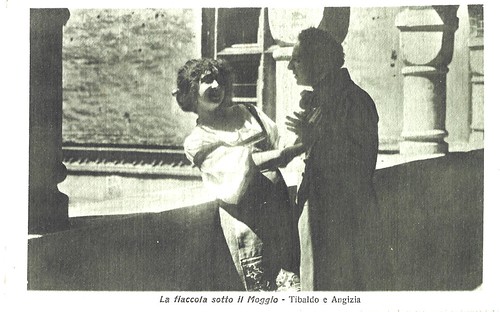
Italian postcard by Duplex IPA CT. V. Uff. Rev. St. Terni, card 2 of 10, no. 3887. Photo: Film. Soc. An. Ambrosio, Torino. Helena Makowska as Angizia and Umberto Mozzato as Tibaldo in La fiaccola sotto il moggio/The Torch under the Bushel (Eleuterio Rodolfi, 1916). Caption: Tibaldo and Angizia.

Italian postcard by Duplex IPA CT. V. Uff. Rev. St. Terni, card 3 of 10, no. 3889. Photo: Film. Soc. An. Ambrosio, Torino. Scene from La fiaccola sotto il moggio/The Torch under the Bushel (Eleuterio Rodolfi, 1916). Caption: Bertrando to Tibaldo: Look at me closely, look me in the eyes, you who speaks of victims. Well, one for sure is printed to the back of your eye, you widower of Monica, and husband of the woman of the marshes. [Gigliola and Donna Aldegrina witness a fight between the two stepbrothers].
A desire for revenge grows in the mind of the young girl
La fiaccola sotto il moggio/The Torch under the Bushel (Eleuterio Rodolfi, 1916) tells the decadent noble family Di Sangro. The family lives in a decrepit castle in the Abruzzi. Gigliola (Anna De Marco) hates her stepmother Angizia (Helena Makowska), a former servant of the family who in order to be able to marry Gigliola's father, Tibaldo (Umberto Mozzato), seduced him and killed his first wife, Monica (Linda Pini).
A desire for revenge grows in the mind of the young girl, only to be fulfilled by killing the perfidious intruder. Before committing her 'justice', she takes poison to atone for the act she is about to commit. But the evil woman is already dead: it is Tibaldo who has preceded his daughter when finding out about his second wife's infidelity and murder. Gigliola dies on her mother's grave, despairing she has been unable to finish her revenge.
Gabriele D'Annunzio's original tale has a partly different plot. Here the point of departure is that the family of Tibaldo and his new wife suffers from moral and physical decadence. A snake breeder, Angizia's father, is hosted by the family but then chased by his daughter, but not before he has cursed her.
Gigliola has managed to get the deadly vipers and be bitten. But before she can act she finds that her father has killed Angizia in order to save his daughter purity but also to atone for his own complicity in killing his wife.
Yet, Italian Wikipedia states an even different, drastic ending: Gigliola dies but also causes the entire decrepit family castle to collapse, giving her father a heart attack and Angizia a defacement. This plot is not confirmed in other sources and it is not visible in the existing print, held by the Museo Nazionale del Cinema. The title of the play and film refers to an Italian expression, meaning being in the possession of a hidden truth.
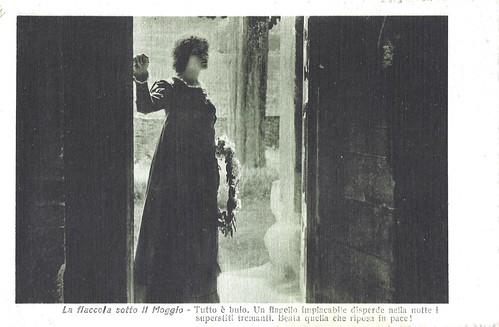
Italian postcard by Duplex IPA CT. V. Uff. Rev. St. Terni, card 4 of 10, no. 3886. Photo: Film. Soc. An. Ambrosio, Torino. Anna De Marco as Gigliola in La fiaccola sotto il moggio/The Torch under the Bushel (Eleuterio Rodolfi, 1916). Caption: All is dark. A relentless scourge scatters the trembling survivors in the night. Blessed is who rests in peace! [Monologue of Donna Aldegrina to her son Tibaldo.]

Italian postcard by Duplex IPA CT. V. Uff. Rev. St. Terni, card 5 of 10, no. 3884. Photo: Film. Soc. An. Ambrosio, Torino. Scene from La fiaccola sotto il moggio/The Torch under the Bushel (Eleuterio Rodolfi, 1916). Caption: Tibaldo to his mother, Donna Aldegrina: Look, am trembling, weaker and more helpless than when I was born from your spasms. [In the play, Angizia and Gigliola are not present when he says so. In this dialogue, Tibaldo confesses to his mother that Angizia has said to Gigliola that she killed her mother. When he afterwards tries to strangle Angizia, his mother holds him back].

Italian postcard by Duplex IPA CT. V. Uff. Rev. St. Terni, card 6 of 10, no. 3882. Photo: Film. Soc. An. Ambrosio, Torino. Helena Makowska as Angizia in La fiaccola sotto il moggio/The Torch under the Bushel (Eleuterio Rodolfi, 1916). Caption: Gigliola: I will only take the dagger. It has a mockingbird's head. It is nice. [Yet, the snake catcher gives her also a bag with poisonous vipers].
Gorgeous tinting and toning in pink and blue for the night scenes
The film critic Tito Alacevich praised La fiaccola sotto il moggio/The Torch under the Bushel (Eleuterio Rodolfi, 1916), after Rodolfi's earlier adaptation of Gabriele D'Annunzio's La Gioconda. He states that at the theatre the audience dislikes D'Annunzio's swollen language, but at the cinema, they just neglect the title cards and enjoy the plot and the characters.
Moreover, the critic praised the performances of the actors, in particular those of Helena Makowska, Anna De Marco and Umberto Mozzato. However, to our standards and compared to the other actors, Mozzato is rather overacting like he did in other films as well.
La fiaccola sotto il moggio/The Torch under the Bushel (Eleuterio Rodolfi, 1916) exists and has been restored by the Museo Nazionale del Cinema. It has gorgeous tinting and toning in pink and blue for the night scenes and shows some interesting exteriors such as the facade of a late medieval castle, a courtyard with heavy columns, etc.
The film was shown at the Cinema Ritrovato festival in Bologna in 2016, 100 years after its production. Italian film historian Claudia Gianetto has written about the film in the Cinema Ritrovato catalogue.

Vintage cover of Duplex card series of 10 cards (complete) by IPA CT.

Italian postcard by Duplex IPA CT. V. Uff. Rev. St. Terni, card 7 of 10, no. 3883. Photo: Film. Soc. An. Ambrosio, Torino. Helena Makowska as Angizia and Filippo Butera as Serparao, her father, in La fiaccola sotto il moggio/The Torch under the Bushel (Eleuterio Rodolfi, 1916). Caption: Serparo: But you, woman, for this bloodstain on the offered linen, hate me. But I tell you: surely as soon as the sun sets, your destiny will be accomplished. Prepare yourself. [Anguzia's father, maltreated and chased by his own daughter, curses her].
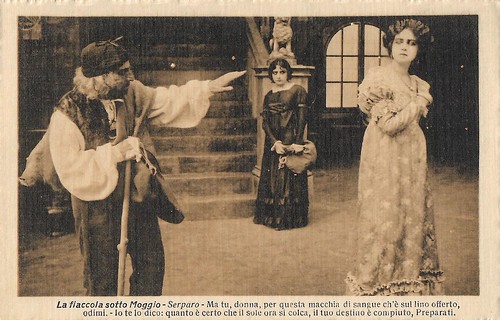
Italian postcard. Photo: Ambrosio. Helena Makowska as Angizia in La fiaccola sotto il moggio/The Torch under the Bushel (Eleuterio Rodolfi, 1916). The 'Serparo' (snake conjurer), played by Filippo Butera, curses his daughter Angizia (Helena Makowska): "You, woman, for this blood stain, which is on the offered linen, you may hate me. But I am telling you: as sure as the sun is now pouring, your destiny is fulfilled. Prepare yourself!" In the back, Angizia's stepdaughter Gigliola (Anna De Marco), suspects her stepmother has killed her mother to marry her father.
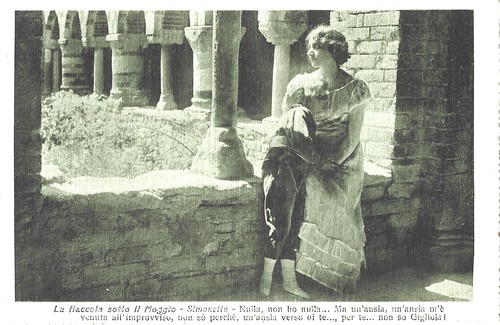
Italian postcard by Duplex IPA CT. V. Uff. Rev. St. Terni, card 8 of 10, no. 3890. Photo: Film. Soc. An. Ambrosio, Torino. Anna De Marco in La fiaccola sotto il moggio (Eleuterio Rodolfi, 1916). Caption: Simonetto: "Nothing, I have nothing... But I suddenly have such an anxiety, I don't know why, about you, for you, I don't know, Gigliola!"

Italian postcard by Duplex IPA CT. V. Uff. Rev. St. Terni, card 9 of 10, no. 3891. Photo: Film. Soc. An. Ambrosio, Torino. Anna De Marco as Gigliola in La fiaccola sotto il moggio (Eleuterio Rodolfi, 1916). Caption: Gigliola: "Mother, give me now the strength to come to you pleased and pacified, to you who left in my soul the vocation of death". [Before her mother's tomb, Gigliola sticks her hands in the bag with the vipers, before killing her stepmother who killed her own mother]
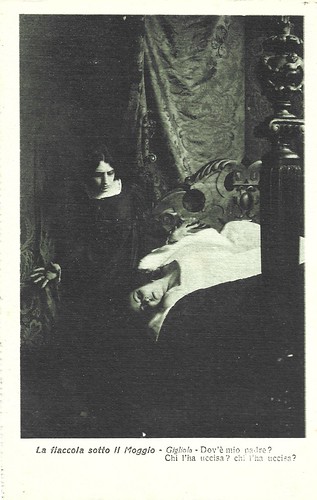
Italian postcard by Duplex IPA CT. V. Uff. Rev. St. Terni, card 10 of 10, no. 3883 (the series has 2x number 3883, so this may rather have been 3888). Photo: Film. Soc. An. Ambrosio, Torino. Anna De Marco in La fiaccola sotto il moggio (Eleuterio Rodolfi, 1916). Caption: Gigliola: Where is my father? Who killed her? Who killed her? [Gigliola is too late to kill her evil stepmother, as her father, overcome with remorse, has already done so].
Sources: Claudia Gianetto (Cinema Ritrovato catalogue), Wikipedia (Italian) and IMDb.
No comments:
Post a Comment